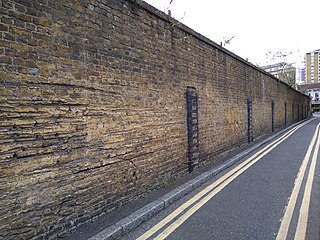
Clerkenwell is an area of central London, England.

The Metropolitan Borough of Finsbury was a metropolitan borough within the County of London from 1900 to 1965, when it was amalgamated with the Metropolitan Borough of Islington to form the London Borough of Islington.

Farringdon Road is a road in Clerkenwell, London.

In Britain and Ireland, a workhouse was an institution where those unable to support themselves financially were offered accommodation and employment. In Scotland, they were usually known as poorhouses. The earliest known use of the term workhouse is from 1631, in an account by the mayor of Abingdon reporting that "we have erected wthn [sic] our borough a workhouse to set poorer people to work".
A vestry was a committee for the local secular and ecclesiastical government of a parish in England, Wales and some English colonies, which originally met in the vestry or sacristy of the parish church, and consequently became known colloquially as the "vestry". At their height, the vestries were the only form of local government in many places and spent nearly one-fifth of the budget of the British government. They were stripped of their secular functions in 1894 and were abolished in 1921.

Leyton was a local government district in southwest Essex, England, from 1873 to 1965. It included the neighbourhoods of Leyton, Leytonstone and Cann Hall. It was suburban to London, forming part of the London postal district and Metropolitan Police District. It now forms the southernmost part of the London Borough of Waltham Forest in Greater London.
Shoreditch (St Leonard) was an ancient parish in the county of Middlesex. It was both a civil parish, used for administrative purposes, and an ecclesiastical parish of the Church of England. The parish church is St Leonard's, Shoreditch, often simply called "Shoreditch Church".
The Metropolitan Asylums Board (MAB) was established under Poor Law legislation to deal with London's sick and poor. It was established by the Metropolitan Poor Act 1867 and dissolved in 1930, when its functions were transferred to the London County Council.

St George Hanover Square was a civil parish in the metropolitan area of London, England. The creation of the parish accompanied the building of the Church of St George's, Hanover Square, constructed by the Commission for Building Fifty New Churches to meet the demands of the growing population. The parish was formed in 1724 from part of the ancient parish of St Martin in the Fields in the Liberty of Westminster and county of Middlesex. It included some of the most fashionable areas of the West End, including Belgravia and Mayfair. Civil parish administration, known as a select vestry, was dominated by members of the British nobility until the parish adopted the Vestries Act 1831. The vestry was reformed again in 1855 by the Metropolis Management Act. In 1889 the parish became part of the County of London and the vestry was abolished in 1900, replaced by Westminster City Council. The parish continued to have nominal existence until 1922. As created, it was a parish for both church and civil purposes, but the boundaries of the ecclesiastical parish were adjusted in 1830, 1835 and 1865.

St Margaret was an ancient parish in the City and Liberty of Westminster and the county of Middlesex. It included the core of modern Westminster, including the Palace of Westminster and the area around, but not including Westminster Abbey. It was divided into St Margaret's and St John's in 1727, to coincide with the building of the Church of St John the Evangelist, constructed by the Commission for Building Fifty New Churches in Smith Square to meet the demands of the growing population, but there continued to be a single vestry for the parishes of St Margaret and St John. This was reformed in 1855 by the Metropolis Management Act, and the two parishes formed the Westminster District until 1887. St Margaret and St John became part of the County of London in 1889. The vestry was abolished in 1900, to be replaced by Westminster City Council, but St Margaret and St John continued to have a nominal existence until 1922.

The Cleveland Street Workhouse is a Georgian property in Cleveland Street, Marylebone, built between 1775 and 1778 for the care of the sick and poor of the parish of St Paul Covent Garden under the Old Poor Law. From 1836, it became the workhouse of the Strand Union of parishes. The building remained in operation until 2005 after witnessing the complex evolution of the healthcare system in England. After functioning as a workhouse, the building became a workhouse infirmary before being acquired by the Middlesex Hospital and finally falling under the NHS. In the last century it was known as the Middlesex Hospital Annexe and the Outpatient Department. It closed to the public in 2005 and it has since been vacated. On 14 March 2011 the entire building became Grade II Listed. Development of the site began in 2019 by current owner University College London Hospitals (UCLH) Charity as a mixed-use development including residential, commercial and open space, but construction has been held up by the necessity to remove human remains stemming from the use of the area around the workhouse as a parish burial ground between 1780 and 1853. There has also been controversy about the amount of social housing to be included in the development.

Saffron Hill, Hatton Garden, Ely Rents and Ely Place was a liberty and from 1866 to 1930 a civil parish in the metropolitan area of London, England. It was part of the ancient parish of St Andrew Holborn.

John Giles was a British architect. He was born in Lincoln, probably in 1830, and his family came from Branston near Lincoln. He was articled to the Lincoln architect Pearson Bellamy. He had moved to London by 1859 and with Pearson Bellamy entered a number competitions for major public buildings. Of these only one, for Grimsby Town, was successful. In London he was responsible for a number of major projects including the Langham Hotel. He also started in 1869 on the design of hospitals with the Infirmary to Hampstead Union Workhouse. After a short period of partnership with Lewis Angel, when Stratford Town Hall was built and with Edward Biven, by 1873 he was in partnership with Albert Edward Gough. They were joined in the practice by J E Trollope and they became involved in the design of Arts and Crafts housing in London's west end. Giles had business interests in the City of London and was noted in 1867 as being a Director of the Imperial Guardian Life Insurance Company.

Liverpool Women's Hospital is a major obstetrics, gynaecology and neonatology research hospital in Liverpool, England. It is one of several specialist hospitals located within the Liverpool City Region, alongside Alder Hey Children's Hospital, Liverpool Heart and Chest Hospital, the Walton Centre, Mersey Regional Burns and Plastic Surgery Unit and Clatterbridge Cancer Centre. It is managed by the Liverpool Women's NHS Foundation Trust. The hospital receives approximately 50,000 patients annually and is the largest hospital for its specialism in Europe.

The historic parish of Bircle, near Bury, England, was created on 1 July 1846, although the village of Bircle has existed for many centuries. It is believed that 'Bircle' is a shortening of the phrase 'Birch Hill', as it was suggested that there were birch trees in the parish. Names such as "Cleggs Wood", "Simpson Clough" and "Dobb Wood" appear on early Ordnance Survey maps. "Hill' appeared in the fourteenth century in the name of 'Birkhill' but it never found a permanent place. Over time its name has also appeared as Brithull, 1243; Birlcil, 1246; Birkhill, 1334, 1573; but Bircle appears in the Diocese of Manchester directory in England.
Workhouse infirmaries were established in the nineteenth century in England. They developed from the Workhouse and were run under the Poor law regime.

The St Luke's Workhouse stood on City Road between Wellesley Terrace and Shepherdess Walk in the parish of St Leonard Shoreditch, today the London Borough of Hackney.

The Clerkenwell Vestry was the vestry of Clerkenwell from c.16th century until 1900. The vestry had growing secular authority over the parish with the relief of the poor its main responsibility. It was incorporated in 1855 as an administrative vestry within the Metropolitan Board of Works area, with local government and sanitary rights and responsibilities added over time.
The St Luke's Vestry was the vestry of St Luke's, an urbanised parish north of the City of London, from 1733 until 1900. The vestry had growing secular authority over the parish with the relief of the poor its main responsibility. It was incorporated in 1855 as an administrative vestry within the Metropolitan Board of Works area, with local government and sanitary rights and responsibilities added over time.

Belfast Union Workhouse was a workhouse operated by Belfast Poor Law Union to provide statutory relief to the destitute in Belfast and the surrounding townlands allocated to it. The workhouse operated from 1841 to 1948, overseen by a Board of Guardians.
















